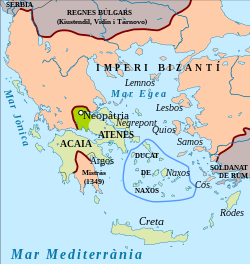Duchy of Neopatras | |||||||||||
|---|---|---|---|---|---|---|---|---|---|---|---|
| 1319–1390 | |||||||||||
 | |||||||||||
| Status | Under the suzerainty of the Kingdom of Sicily, after itself part of Crown of Aragon | ||||||||||
| Capital | Neopatras | ||||||||||
| Common languages | Greek popularly | ||||||||||
| Religion | Roman Catholic officially, Greek Orthodox popularly | ||||||||||
| Government | Feudal duchy | ||||||||||
| Historical era | Middle Ages | ||||||||||
• Sicilian capture of Neopatras by Frederick Alfonso of Sicily | 1319 | ||||||||||
• Neopatras conquered by Nerio I Acciaioli | 1390 | ||||||||||
| |||||||||||
The Duchy of Neopatras (Catalan: Ducat de Neopàtria; Sicilian: Ducatu di Neopatria; Greek: Δουκάτο Νέων Πατρών; Latin: Ducatus Neopatriae) was a principality in southern Thessaly, established in 1319. Officially part of the Kingdom of Sicily, itself part of the Crown of Aragon, the duchy was governed in conjunction with the neighbouring Duchy of Athens, it enjoyed a large degree of self-government. From the mid-14th century, the duchies entered a period of decline: most of the Thessalian possessions were lost to the Serbian Empire, internal dissensions arose, along with the menace of Turkish piracy in the Aegean and the onset of Ottoman expansion in the Balkans. Enfeebled, the Catalan possessions were taken over by the Florentine adventurer Nerio I Acciaioli in 1385–1390. The title of Duke of Neopatras was held by the heir of the King of Sicily.[1]
- ^ Nardi, Carlo (1747). De' titoli del Re delle Due Sicilie (PDF) (in Italian).
